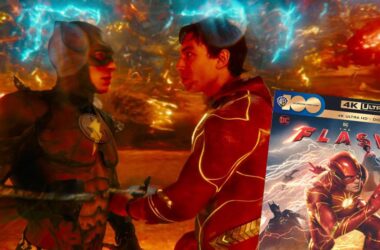Here’s a look at a few of the best and coolest gift ideas for video gamers in the family.
The Games
Let’s start with the great gift examples of highly entertaining and immersive gaming experiences.
Lords of the Fallen: Deluxe Edition (CI Games and Hexworks, rated M, reviewed with PlayStation 5, $79.99) — Recent years have brought a wave of nearly impossible to conquer third-person, Dark Souls-style, role-playing games, and Lords of the Fallen fits into the pack like a well-worn spiked leather glove.
Visually reminiscent of FromSoftware’s Elden Ring, the semi-open-world action has a solo player take an addictive plunge into a fantasy universe with breathtaking graphics and punishing combat.
Like its brethren, the action takes place in a fantasy kingdom rocked with demons, ghouls, and other nefarious foes for players to fight.
However, Lords of the Fallen deliciously seems to occur between two different planes. Using an Umbral Lamp, a player warps between Axiom, the land of the living, and Umbral, the domain of the dead.
The worlds are layered on top of each other, as paths or barriers that exist in Axiom may disappear or appear in Umbral. This mechanism offers new enemies and alternative routes to discover the various secrets throughout the maps.
Start with character creation, another staple to the genre, with nine different classes to pick from (10 if you include the deluxe edition Dark Crusader class) and each with a distinct combat style, unique armor and base stats.
In terms of facial and body customizations, it’s extensive with the ability to nearly duplicate a player’s own likeness. The Deluxe Edition also includes a digital artbook, soundtrack and 3D model viewer that allows players to examine enemies and character art in more detail.
For example, in choosing a Dark Crusader class, players move through Axiom with the goal of defeating the demon-god Adyr.
The combat mechanics are standard, with light, heavy and charged attacks. However, combat in the Umbral offers more weapons to use such as the Umbral Lamp to “soulflay” enemies, which rips the soul out of the foe like a dementor in Harry Potter.
The first real boss of the game, Pieta She of Blessed Renewal (a winged, magic-infused knight dressed in blood-red armor), is an excellent example of what’s in store for a player and a good first hurdle to cross.
In this boss fight, the main combat mechanic is revealed: Blocking/parrying hits from enemies drain their stagger meters, eventually allowing players to perform a large visceral attack.
Lords of the Fallen also has a “second chance” system, where if the character dies, they emerge again in the Umbral, with about half health left. After defeating Pieta, players continue to the main hub, the Skyrest Bridge. Here, players are able to purchase and buy combat gear and upgrade materials to continue to build their character.
Stunning on both production values and combat ferocity, Lords of the Fallen is a great combination of many Dark Souls tropes. Despite some of its retreads, it will thrill new gamers to the genre looking to get deeply lost and lock themselves into a 50-hour odyssey of swords and sorcery.
Starfield (Bethesda Softworks and Bethesda Game Studios, rated M, reviewed with Xbox Series X|S, $69.99) — This open-world, rather, open-galaxy action-adventure role-playing game takes place deep in the cosmos featuring stunning graphics, quirky characters and plenty of space travel.
The story opens on the moon of Vectra in the year 2330. A space miner (called a dusty) searches through a deep and dark location for beryllium. Suddenly, he enters a fairly ominous tunnel and finds … something. Picking up the mysterious metal, the character’s mind is seemingly transported through time and space.
Upon waking up in an infirmary, a player must now customize their miner’s look, background and unique traits, a nearly exhaustible task that includes choosing from 20 different “backgrounds,” each of which start with three different skills.
A player is now thrown into the first- and third-person action after meeting with Barrett, a mysterious client interested in purchasing the strange piece of metal, which he dubs an “artifact.”
Suddenly, a ship of pirates appears, and the player must help to fight them off. The beginning weapon is actually a mining tool, a cutter, with unlimited ammo but very limited range and damage.
Throughout the game, a player is then able to collect new weapons from the bodies of enemies and from weapon crates. After defeating the pirates, Barrett tasks the player with delivering the artifact to the Constellation, a band of space explorers who have apparently found other pieces like the artifact.
That sets up the game as a player becomes the new captain of the Frontier, Barrett’s spaceship, and gets help from his C3PO-like assistant, Vasco. Vasco helps the player throughout the game by allowing that person to offload items into his inventory. This is incredibly useful because, in Starfield, players can loot pretty much any item imaginable, from weapons to pens and succulent plants.
While many recent games have included an aspect of space transportation, Starfield stands out by allowing players to not only build, buy and commandeer ships but fight in space battles with enemies. There is a definite learning curve in successfully controlling and handling the space combat, but after players have the hang of it, it’s pretty darn fun.
In Starfield, players are able to travel across the galaxy to help the Constellation find the other mysterious artifacts, all the while being able to complete various side missions. They can even have characters create a home base on several different planets.
The amount of freedom given to players in Starfield is as liberating as daunting, as a player roams indefinitely through planetary systems (landing on more than 1,000 planets) and never knows what items are truly important to collect or what options are most prudent until it’s too late.
Suffice it to report, fans of sci-fi fantasy and Star Wars will immediately fall in love and may never leave their entertainment caves.
Alan Wake II (Epic Games Publishing and Remedy Entertainment, rated M, reviewed with Xbox Series X|S, $59.99) — A long-awaited sequel to the 2010 classic delivers a third-person survival horror game that plays like a psychological supernatural thriller. The game features a mind-bending and engaging story supplemented with incredible graphics and live-action segments.
In the narrative, a solo player switches between two protagonists: Saga Anderson, a bright and curious FBI agent, and the titular Alan Wake, a writer battling with the supernatural as it creeps into his reality.
One of the highlights from the start is the voice acting and obvious care given to each of the characters, both big and small. Through small details in conversations and exposition, the characters become full-bodied personas, making players root for some to succeed and for others to fail.
On the surface, the game resembles an episode of HBO’s “True Detective” as Saga and her partner, Alex Casey, begin to investigate the ritualistic murder of ex-FBI agent Robert Nightingale, who was found brutally murdered after going missing 13 years prior.
However, the game quickly flips from a detective story to a full-blown supernatural adventure when Nightingale comes back to life in the morgue, attacking Saga and others.
Now, Saga must venture into “The Overlap,” a space between our world and something more sinister, in order to discover the secrets behind Nightingale’s resurrection and his suspected killers, the Cult of the Tree.
About an hour into the action, Saga discovers Alan Wake after he’s seemingly washed up on the shore near the murder site, also having been missing for 13 years. Now, Saga and Alan must work together to defeat not only the Cult of the Tree, but their own inner demons and the supernatural forces attempting to stand in their way.
Alan Wake II is a breath of fresh air for horror fans and true crime fans alike with its genuinely scary but rewarding style of play.
While it does involve jump scares to keep players on their toes, the more bone-chilling atmosphere of the story and the visual styles used to portray it are the truly thrilling aspects.
The story uses sporadic live-action scenes to unnerve and disorient players and make them question whether they can really trust what they’re seeing. The game also makes use of Saga’s Mind Place, a play on the Mind Palace technique that allows players to physically piece together clues and deductions to reveal the larger conspiracies at work.
Alan Wake II stands out as an entertaining gift for survival horror fans, integrating the supernatural with the real world in a mind-bending story that’s sure to keep a player hooked.
RoboCop: Rogue City (Nacon and Teyon, rated M, reviewed with Xbox Series X|S, $59.99) — Fans of police Officer Alex Murphy and his cybernetic alter ego are in for a treat in this first-person shooter following the legendary RoboCop as he fights to clean up the city of Old Detroit, which has been overrun with criminal activity.
With a story taking place between the cinematic events of “RoboCop 2” and “RoboCop 3,” the action begins during a hostage situation at a news studio perpetrated by Soot, a gang leader, and his Torch Head minions. During a standoff between a gunman holding a woman hostage, RoboCop freezes due to flashbacks in his life and hallucinates that the female hostage is his wife.
This “malfunction” causes his partner, Officer Anne Lewis, to have to step in. RoboCop’s malfunction was filmed and released, leading to questions of his efficacy and viability as a crime-fighting machine.
After this mishap, a computer chip is placed in RoboCop’s head to “monitor his performance.” This chip acts as an update and upgrade system in the game. After each mission, players receive a letter grade based on tasks completed and side content explored.
Throughout the game, players play as RoboCop as he completes side missions related to Soot and the rapidly spreading drug Nuke. RoboCop also acts as a street cop, passing out parking tickets and warnings for graffiti.
However, players will be able to choose how they interact with the various (named) criminals throughout the game, as they’re able to choose how/if they’re punished by the law.
The game can be sadistically bloody and violent at times, as players go around mowing down Torch Heads in abandoned buildings and alleyways using RoboCop’s expanding arsenal including his Auto 9 pistol with unlimited ammo.
The skills system in the game is pretty basic, as each level gifts a point that can be used to upgrade various categories. Some are simple such as vitality (health), armor and combat, while others allow players to perform more nuanced interactions with the environment.
At times the graphics look a tad outdated and the dialogue synced with mouths is pretty rough, but the mythos and black humor remain intact, and best of all, the RoboCop, actor Peter Weller, returned to provide his voice and likeness.
For fans of the franchise, RoboCop: Rogue City will be a welcomed flashback to the films and the characters.
Mortal Kombat 1 (Warner Bros. Games and NeatherRealm Studios, rated M, reviewed with Xbox Series X|S, $59.99) — The three-decade-old franchise that pushed the limits of exposing gamers to extreme visceral violence inside side-scrolling fight arenas returns for another round and going back to its roots to deliver some horrifying action.
Mortal Kombat I follows many of the same themes and mechanics of its predecessors with some new additions while acting as a reboot of the first Mortal Kombat from 1992 and a sequel to Mortal Kombat 11.
The story follows a new timeline formed by fire god Liu Kang and opens with a tutorial scene in a remote village in Fenglian Province. Kung Lao and Raiden, simple farm hands with surprising martial arts skills, must defend the honor of Madam Bo when she is confronted by the Lin Kuei. During these sequences, players fight Smoke, Sub-Zero and Scorpion.
The combat is fluid and fairly simple, allowing players to learn combos and controls, but the fights themselves are not easy, challenging players from the start.
Suddenly, Lord Liu Kang appears and claims that the Liu Kuei members were sent by him to test Kung Lao and Raiden’s abilities. Throughout the rest of the story chapters, players control various iconic characters including Johnny Cage, Raiden, Kenshi Takahashi, Reptile and more Sub-Zero to name a few.
In the player-versus-player matches, there are almost two dozen fighters available to choose from. If the base characters are not enough, the premium edition has the “Kombat Pack,” which includes characters







